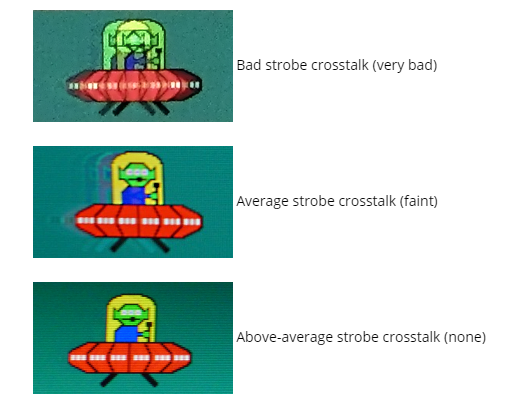miszt wrote: ↑22 Mar 2020, 11:23
Thanks for your reply, chief! It'a great help.
However, I'm curious about the phrase that
"Refresh rate headroom below Hz is good for strobe quality. 120Hz strobing on a 240Hz monitor is typically better than 120Hz strobing on a 144Hz monitor or 144Hz strobing on a 144Hz monitor."
Is there any theorical explanation about why this happens??
It's not theory. It's real science.
Strobe crosstalk.

To improve this, you have to hide more LCD GtG in total darkness between strobe backlight flashes.
You need a bigger ratio of refresh time versus GtG time, to reduce strobe crosstalk.
In other words, cramming GtG into the VBI. (VBI = the Vertical Blanking Interval = the pause between refresh cycles).
View
www.blurbusters.com/scanout and
www.blurbusters.com/redphosphor and click Play on the high speed videos.
LCDs don't refresh all pixels at the same time. The LCD GtG lags after a pixel begins to refresh. And only one pixel row is refreshed at a time. So in high speed videos, you've got a Star Wars style "fade wipe" effect going from top edge to bottom edge where the new refresh cycle replaces the old refresh cycle.
The art of cramming the GtG into the VBI, is to finish LCD pixel transitions at the bottom edge of the screen BEFORE beginning to refresh the next re
NON-STROBED: This is what a
slow LCD screen looks like when refreshing, in super-slow-motion, via 960fps high speed video
NON-STROBED: This is what a
fast LCD screen looks like when refreshing, in super-slow-motion, via 960fps high speed video
STROBED: Now when strobing, one only wants the monitor to flash the backlight when the screen is between sweeps:
This is easiest with faster GtG and longer VBIs. Longer VBIs are easier with low refresh rates on high refresh rate panels.
This is much easier at lower refresh rates. At 120Hz refresh rate on a 240Hz panel, it is possible to set things up so that it still scanout the refresh cycle in 1/240sec (complete your refresh sweep in 1/240sec), creating 4.2ms pause between refresh cycles. That 4.2ms pause is enough to hide LCD GtG in the total darkness between strobe backlight flashes, before flashing (for about ~1ms) before begininng a new refresh cycle. So full-velocity refresh cycles at lower refresh rates, is what's done.
(That's why Large Vertical Totals used to be popular on older BenQ monitors -- they forced higher-velocity refresh cycles combined with longer pauses between refresh cycles. If you've read stuff like "VT1350", that meant that a screen was spending only 1080/1350ths of a refresh cycle scanning out, with the remainder of the time being a pause between refresh cycles. The larger the VT, the longer the pause between refresh cycles).
So, that's why refresh rate headroom is wonderful for reducing strobe crosstalk. You can max the scanout velocity at the max Hz (e.g. 1/240sec for 240Hz monitors) despite running at a lower refresh rate such as 100Hz. This can either be done at the signal level (Quick Frame Transport / Large Vertical Total) or at the TCON/scaler level (scan-converting an incoming lower horizontal scanrate to a higher horizontal scan rate in number of pixel rows per second).
I milk this intentionally as part of the
Blur Busters Approved programme, that's why the XG270 has one of the best IPS strobing at 100Hz and 120Hz refresh rates.


